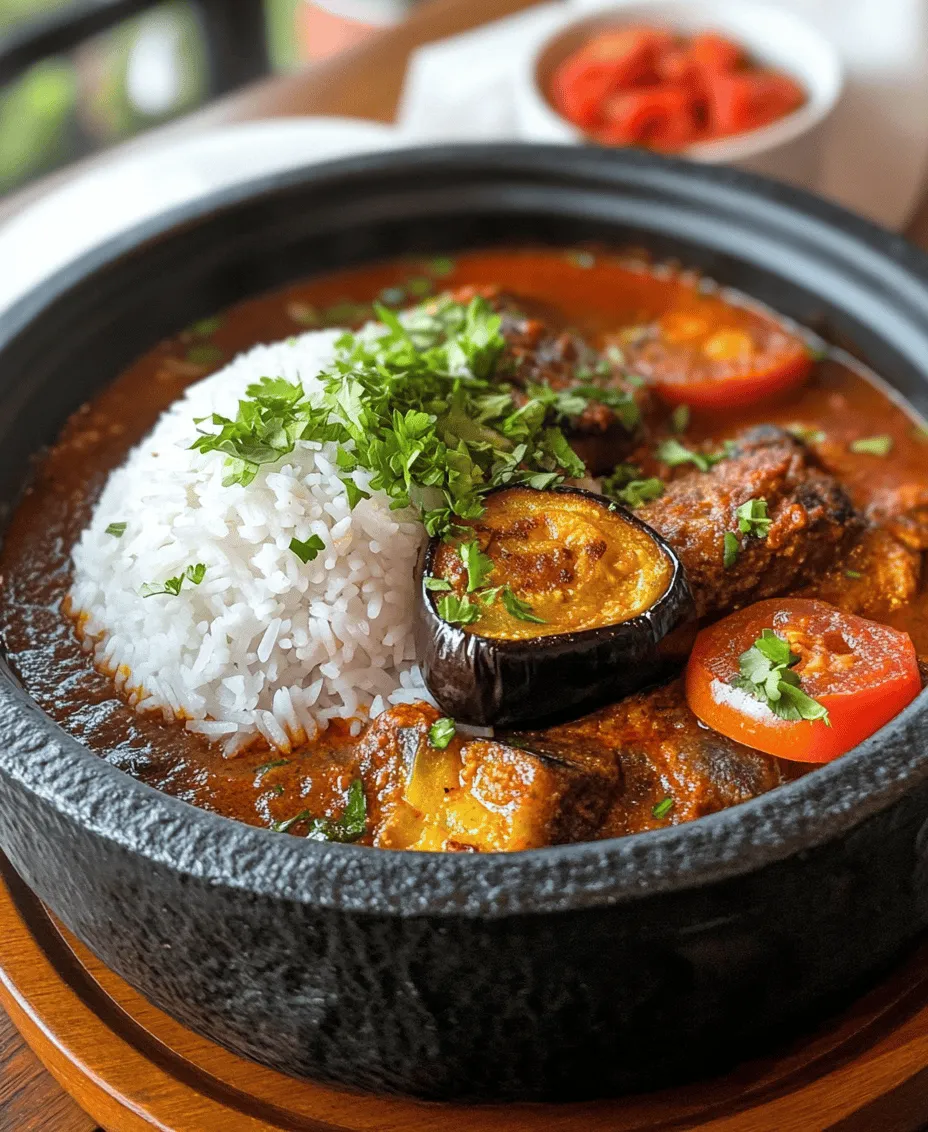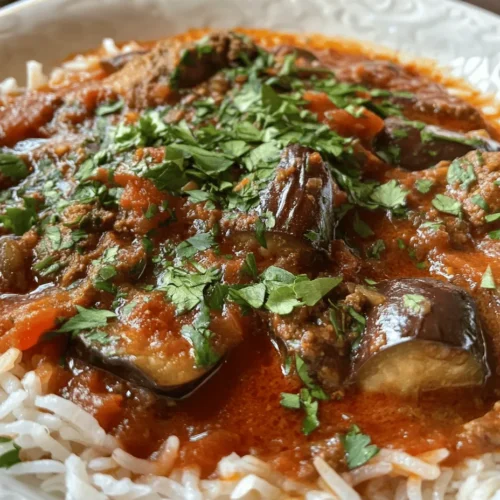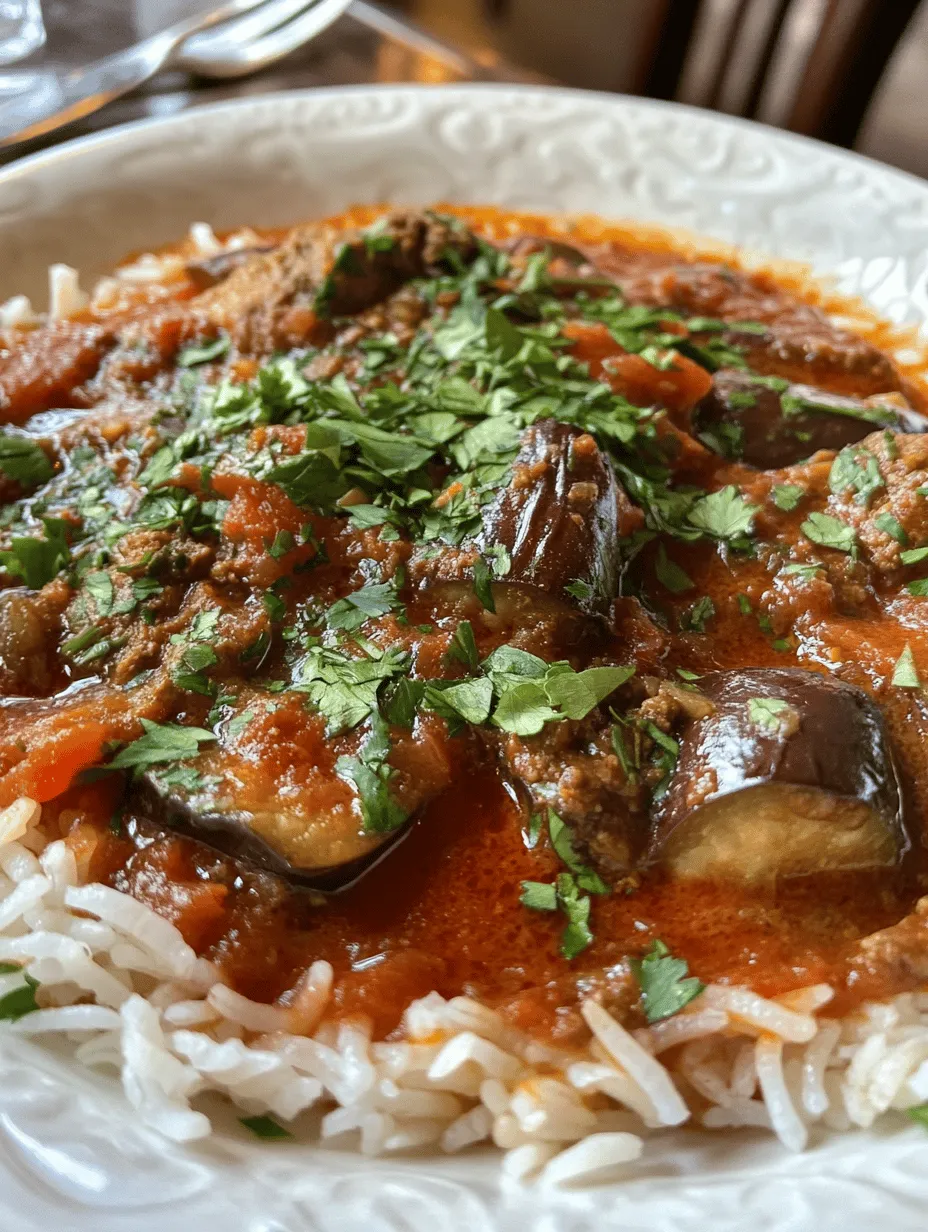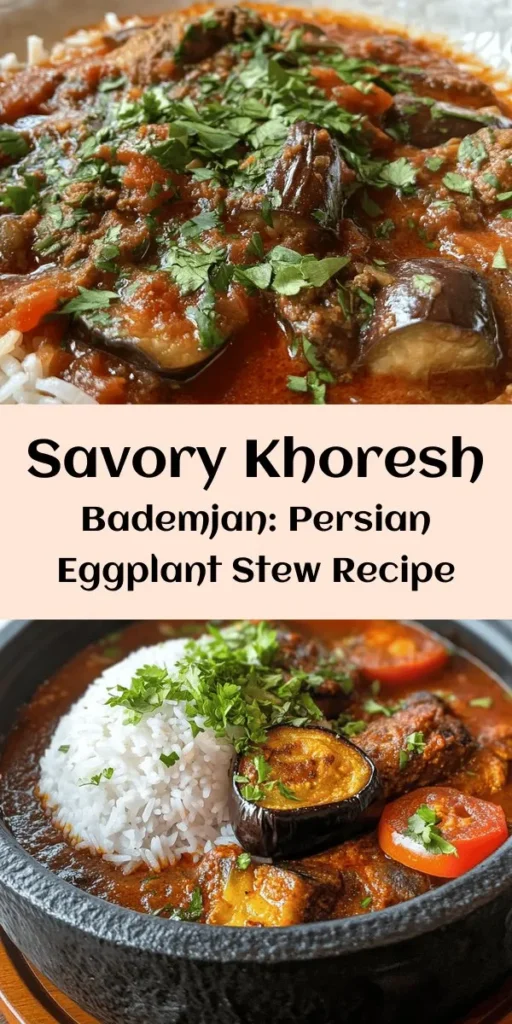Introduction
Khoresh Bademjan is a celebrated dish in Persian cuisine, often referred to as the “eggplant stew.” This rich and hearty stew showcases the unique flavors of the Middle East, with eggplant as its star ingredient. Not only is Khoresh Bademjan a staple in Persian households, but it also represents the cultural heritage and culinary traditions of Iran. The dish is a perfect example of how simple ingredients can be transformed into a comforting meal that warms both the body and soul.
Eggplant, known as “bademjan” in Persian, holds a prominent place in Middle Eastern dishes due to its unique texture and ability to absorb flavors. This vegetable is not only delicious but also packed with health benefits, including antioxidants, vitamins, and minerals. Its versatility allows it to be prepared in various ways, making it a favorite among both meat lovers and vegans alike. In Khoresh Bademjan, eggplant takes center stage alongside tender meat or hearty plant-based alternatives, creating a dish that caters to diverse dietary preferences.
Whether served at a family gathering, a festive occasion, or a simple weeknight dinner, Khoresh Bademjan is bound to impress. Its adaptable nature makes it easy to customize, whether you choose to include lamb, beef, or skip the meat altogether for a vegan version. The resulting dish is always rich in flavor and deeply satisfying, making it a cherished recipe within Persian culinary culture.
Exploring Khoresh Bademjan
Khoresh Bademjan is more than just a meal; it is a culinary experience that reflects the heart of Persian culture. This comforting stew is traditionally served with fluffy basmati rice, creating a delightful contrast of textures and flavors. The creamy, melt-in-your-mouth eggplant pairs beautifully with the tender meat, while the aromatic spices elevate the dish to new heights. Each bite transports you to the vibrant streets of Iran, where food is not just sustenance but a means of connection and celebration.
The cultural significance of Khoresh Bademjan dates back centuries, with its roots deeply embedded in Persian history. Stews like this were often prepared for special occasions, symbolizing hospitality and generosity. The technique of slow-cooking the ingredients allows the flavors to meld and develop, resulting in a dish that is both complex and comforting. It is not uncommon for families to have their own variations of Khoresh Bademjan, passed down through generations, each recipe telling a story of its own.
The flavor profile of Khoresh Bademjan is a harmonious blend of savory, tangy, and aromatic notes. The use of spices plays a crucial role in enhancing the dish’s depth; turmeric provides an earthy warmth, cinnamon adds a hint of sweetness, and cumin contributes a distinctive aroma. Together, these spices create a fragrant base that complements the richness of the eggplant and meat. Additionally, the inclusion of tomatoes—whether fresh or canned—introduces a subtle acidity that balances the dish.
Ingredients Breakdown
Creating a delicious Khoresh Bademjan requires a selection of key ingredients that come together to create a flavorful stew. Below is an overview of the essential elements that make this dish so special.
Eggplants
Eggplants are the heart of Khoresh Bademjan. Their unique texture and ability to absorb flavors make them essential in this recipe. To prepare the eggplants, it is important to reduce their natural bitterness, a common characteristic of this vegetable. This can be achieved by slicing the eggplants and sprinkling them with salt, allowing them to sit for about 30 minutes. This process draws out excess moisture and bitterness, resulting in a sweeter and creamier texture once cooked. After salting, rinse and pat the eggplants dry before frying or roasting them to enhance their flavor and texture in the stew.
Meat Options
For those who enjoy meat, Khoresh Bademjan can be made with tender cuts of lamb or beef, which add richness to the dish. The meat is typically cut into bite-sized pieces and browned before being added to the stew. If you’re looking for a vegan option, you can easily substitute the meat with hearty vegetables, lentils, or chickpeas. These alternatives not only maintain the dish’s integrity but also provide a satisfying source of protein for plant-based eaters.
Tomatoes
Tomatoes are another vital ingredient in Khoresh Bademjan, contributing both flavor and color to the stew. You can opt for fresh tomatoes or canned varieties, depending on availability and seasonality. Fresh tomatoes can provide a bright and vibrant taste, while canned tomatoes offer convenience and consistency. Regardless of your choice, the tomatoes should be cooked down to create a rich, thick sauce that envelops the eggplant and meat.
Spices
The spices used in Khoresh Bademjan are paramount to achieving an authentic Persian flavor. Turmeric, often referred to as the golden spice, imparts a warm, earthy taste and a beautiful golden hue to the stew. Cinnamon, a staple in Persian cooking, adds a sweet and aromatic depth that contrasts beautifully with the savory elements. Cumin, with its nutty and warm flavor, rounds out the spice profile, creating a well-balanced dish that is both comforting and exotic.
Vegetable Broth and Lemon Juice
To achieve a rich and flavorful base for the stew, vegetable broth is often used. This adds depth without overpowering the delicate flavors of the eggplant and spices. Additionally, a splash of lemon juice at the end of cooking brightens the dish, enhancing its overall flavor profile. The acidity from the lemon complements the richness of the eggplant and meat, resulting in a well-rounded and satisfying stew.
Preparation Steps
To prepare Khoresh Bademjan, follow these step-by-step instructions to ensure a delicious outcome.
1. Prepare the Eggplants: Begin by slicing the eggplants into thick rounds. Sprinkle them generously with salt and let them sit for about 30 minutes. This will help draw out bitterness. Afterward, rinse the eggplants under cold water and pat them dry with paper towels.
2. Fry the Eggplants: Heat a generous amount of oil in a large pot or deep skillet over medium heat. Once the oil is hot, add the eggplant slices in batches, frying until they are golden brown and tender. Remove the fried eggplants from the pot and set them aside on a paper towel to drain excess oil.
3. Cook the Meat: In the same pot used for frying the eggplants, add a little more oil if necessary. Increase the heat to medium-high and add your choice of diced lamb or beef. Sear the meat until it is browned on all sides. This step is essential for developing flavor.
4. Add Onions and Spices: Once the meat is browned, add finely chopped onions to the pot. Sauté the onions until they are translucent and fragrant, about 5 minutes. Next, incorporate the turmeric, cinnamon, and cumin, stirring well to coat the meat and onions with the spices.
5. Combine Ingredients: Add the prepared tomatoes (fresh or canned) to the pot, along with the fried eggplants. Pour in the vegetable broth, ensuring that the ingredients are submerged. Bring the mixture to a gentle simmer.
6. Simmer the Stew: Reduce the heat to low, cover the pot, and let the stew simmer for about 1 to 1.5 hours. This slow cooking allows the flavors to meld and the meat to become tender. Stir occasionally, adding more broth if needed to maintain the desired consistency.
7. Finish with Lemon Juice: Once the stew is cooked, taste and adjust seasonings as necessary. A squeeze of fresh lemon juice just before serving can elevate the dish, adding brightness and balancing the richness of the stew.
By following these steps, you’ll create a delicious Khoresh Bademjan that embodies the essence of Persian cuisine. This dish is not only a delight to the palate but also a testament to the culinary traditions that have been cherished for generations.
Further details on serving suggestions, variations, and tips for perfecting your Khoresh Bademjan will follow in the next section of this article.

Preparing the Eggplants
Eggplants play a pivotal role in Khoresh Bademjan, both in texture and flavor. Salting the eggplants before cooking is a crucial step that should not be overlooked. This process helps draw out excess moisture, which can lead to a soggy dish. Additionally, salting helps to reduce bitterness, resulting in a more palatable final product. To do this, slice your eggplants into 1-inch thick rounds or half-moons, depending on your preference. Generously sprinkle salt on both sides of the slices and let them sit for about 30 minutes. Afterward, rinse the eggplants under cold water to remove the salt and any bitterness, then pat them dry with paper towels.
Techniques for Frying Eggplants
Frying the eggplants correctly is essential for achieving the desired tender yet slightly crispy texture that Khoresh Bademjan is known for. To fry the eggplants, heat a generous amount of vegetable oil in a large skillet over medium-high heat. Once the oil is hot, gently place the salted and dried eggplant slices into the skillet, making sure not to overcrowd the pan. Fry them for about 3-4 minutes on each side until they turn golden brown. It’s essential to maintain the heat; if the oil is too cool, the eggplants will absorb too much oil and become greasy instead of crisp. Once cooked, transfer the eggplants to a plate lined with paper towels to drain excess oil.
Sautéing Onions and Garlic
The base of Khoresh Bademjan is made aromatic by sautéing onions and garlic. In the same skillet used for frying the eggplants (after draining the oil), add a little more oil if necessary and heat it over medium heat. Add finely chopped onions, stirring occasionally until they become translucent and begin to caramelize, which should take about 5-7 minutes. Next, add minced garlic and sauté for another minute until fragrant. This aromatic foundation is essential as it infuses the stew with deep flavor, setting the stage for the other ingredients.
Browning the Meat
To ensure that the meat in your Khoresh Bademjan is flavorful and tender, browning it properly is crucial. After removing the sautéed onions and garlic from the skillet, add your choice of meat—lamb or beef—cut into bite-sized pieces. Increase the heat to medium-high, allowing the meat to sear on all sides, which should take about 7-10 minutes. As the meat browns, it will develop a rich color and depth of flavor. Don’t rush this step; the caramelization of the meat is vital for a hearty stew.
Incorporating Spices and Tomatoes
Once the meat is browned, it’s time to incorporate the spices and tomatoes that will elevate your Khoresh Bademjan. Add turmeric, cinnamon, and black pepper to the meat, stirring to coat it evenly with the spices. This combination will give the stew a warm, earthy flavor. Next, add diced tomatoes, either fresh or canned, along with some tomato paste for richness. Stir everything together and let the mixture cook for about 5 minutes, allowing the tomatoes to break down and meld with the spices, forming a thick sauce that envelops the meat.
Simmering the Stew
Patience is key when it comes to simmering Khoresh Bademjan. Once the meat and tomato mixture is well-combined, add enough water or broth to cover the ingredients. Bring the stew to a gentle boil, then reduce the heat to low, covering the pot with a lid. Let it simmer for at least 1.5 to 2 hours, stirring occasionally. This slow cooking process allows the flavors to meld beautifully and ensures that the meat becomes tender. The longer you let it simmer, the richer the flavor will become.
Combining Eggplants
After your stew has simmered for a while, it’s time to add the fried eggplants. Carefully nestle the eggplant slices into the stew, ensuring they are evenly distributed and submerged in the flavorful broth. Avoid stirring too vigorously, as this can break the eggplants apart. Instead, gently shake the pot or use a spatula to help combine the ingredients without damaging the eggplants. Allow the stew to simmer for an additional 30 minutes so that the eggplants absorb the flavors of the sauce.
Serving Suggestions
Khoresh Bademjan is traditionally served with fluffy basmati rice, which complements the rich flavors of the stew perfectly. The light, aromatic rice acts as a neutral base that balances the intensity of the Khoresh. When plating, fluff the rice with a fork and create a small well in the center to ladle the stew.
For added freshness, garnish your dish with chopped parsley or cilantro, which not only enhances the visual appeal but also adds a burst of flavor. Consider serving a side of yogurt or a tangy cucumber salad to provide a refreshing contrast to the rich stew. A simple green salad dressed with lemon and olive oil can also serve as a delightful accompaniment, balancing the meal with its crispness.
Nutritional Benefits
Eggplants, the star ingredient of Khoresh Bademjan, are packed with health benefits. They are low in calories and high in fiber, making them a great choice for those looking to maintain a healthy weight. Additionally, eggplants contain antioxidants, including nasunin, which is known to protect brain cells and improve overall health.
When considering the nutritional profile of Khoresh Bademjan, a meat version offers protein and iron, while a vegan version can be equally satisfying by substituting the meat with lentils or chickpeas. This versatility allows you to cater to various dietary preferences while still enjoying the rich flavors of the dish. Portion sizes can be adjusted based on individual dietary needs, but a serving with a generous helping of basmati rice and a side salad provides a balanced meal.
Conclusion
Khoresh Bademjan is more than just a stew; it represents a beautiful tapestry of Persian culinary tradition, rich in flavors and cultural significance. This dish not only delights the palate but also warms the soul, making it a cherished recipe in many households. Its versatility allows it to cater to different dietary preferences, whether you choose the traditional meat version or a plant-based alternative.
By trying this traditional recipe at home, you’ll not only experience the joy of cooking but also the satisfaction of serving a dish that encapsulates the warmth and hospitality inherent in Persian culture. With its rich flavors and heartwarming aroma, Khoresh Bademjan is sure to become a beloved addition to your culinary repertoire. Embrace the journey of creating this stew, and savor the delightful flavors that await you.



